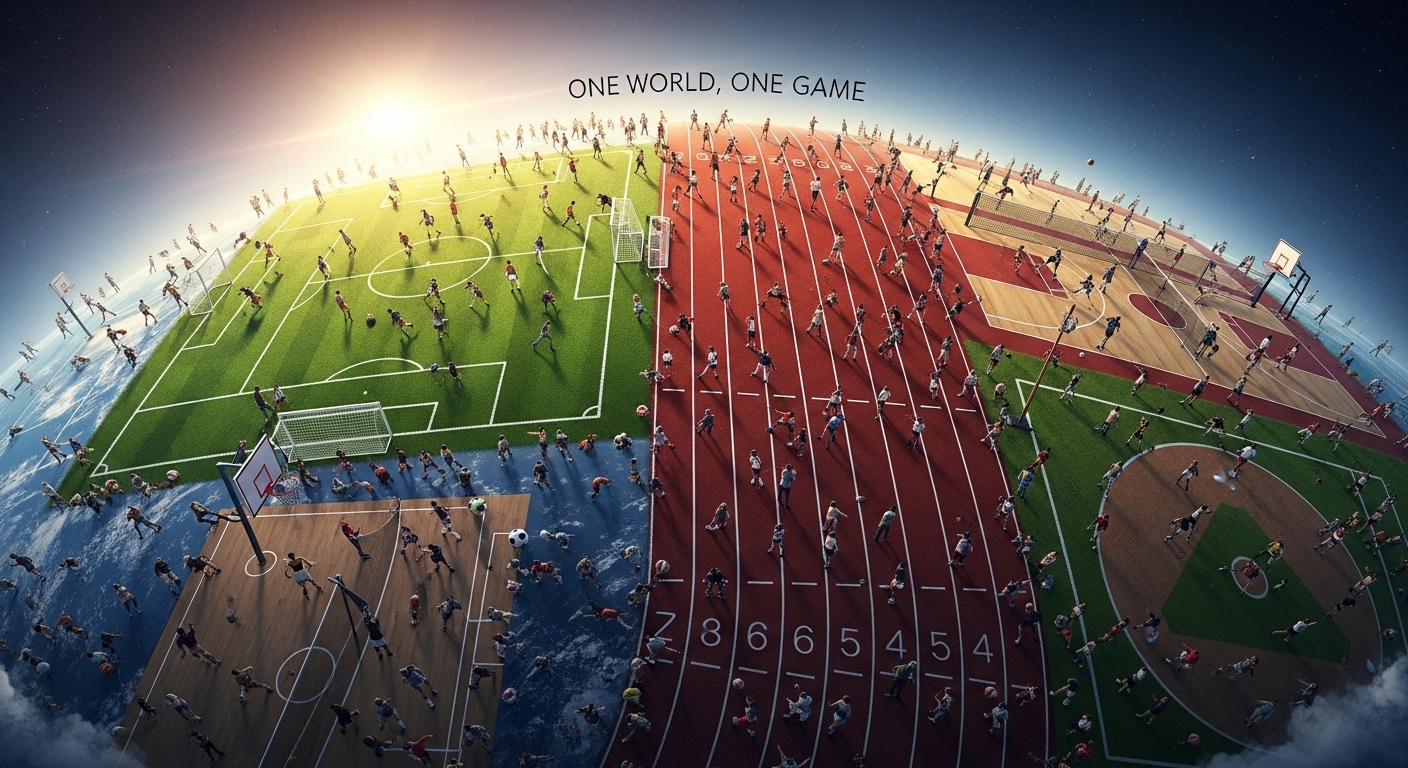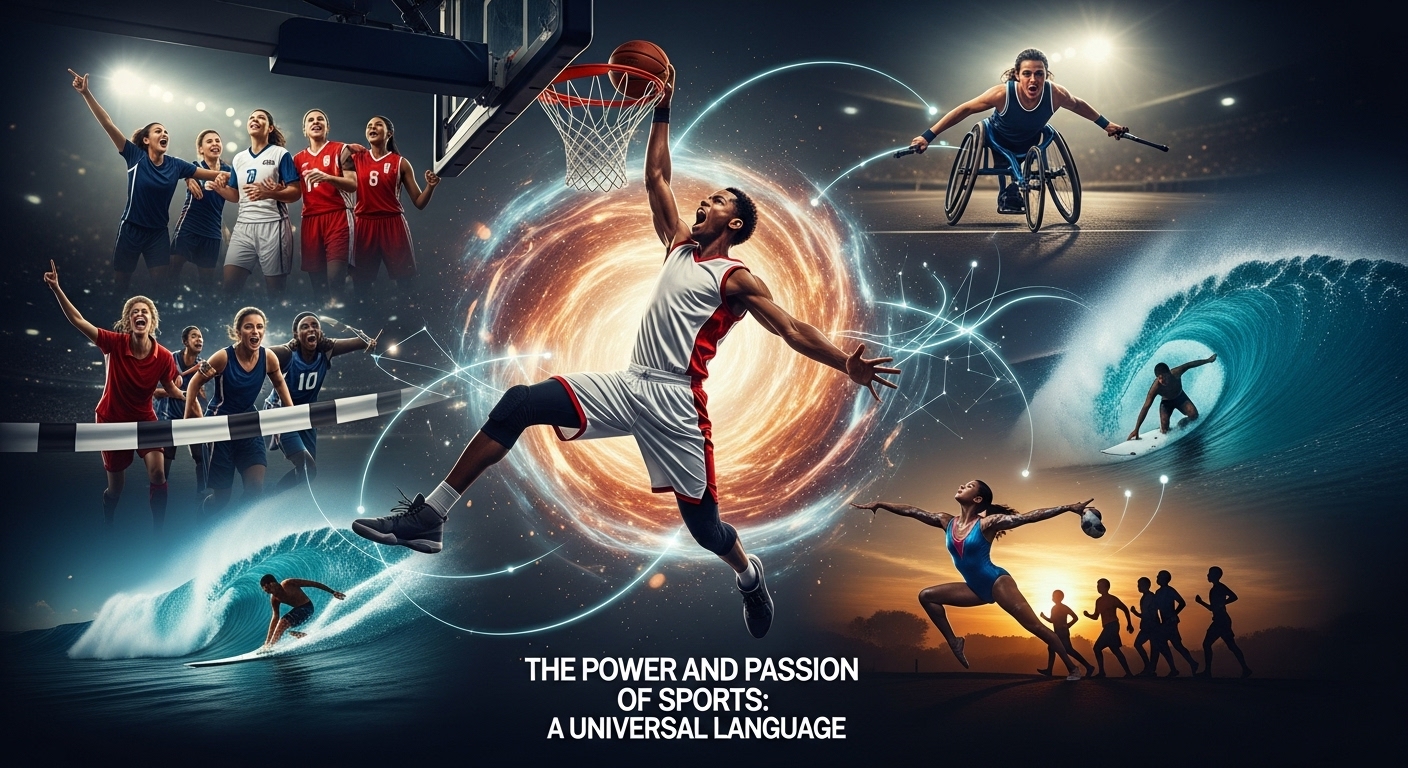Introduction
Sports have been an inseparable part of human civilization since ancient times. From the earliest days when primitive humans competed in hunting or wrestling for survival and entertainment, to today’s billion-dollar international sporting events broadcast globally, the world of sports has evolved dramatically. Sports are more than just physical activities; they are an expression of culture, identity, resilience, and human potential. They have the power to unite people across boundaries, transcend differences, and inspire generations. Whether played on a dusty village field or inside a massive stadium filled with thousands of cheering fans, sports hold a universal charm that continues to shape societies and individuals alike.
This blog explores the multifaceted world of sports — tracing their history, understanding their significance, analyzing their impact on health and culture, examining the influence of technology, and discussing the challenges they face in the modern era.
The Origins and Evolution of Sports
The history of sports is as old as humanity itself. Archaeological evidence shows that organized sporting activities existed thousands of years ago in ancient civilizations such as Egypt, Greece, China, and the Indus Valley. Early forms of sports often had ritualistic or military significance. For example, wrestling and running competitions in ancient Greece were not only displays of strength but also a tribute to the gods. The Olympic Games, which originated in Olympia in 776 BC, were a celebration of both human excellence and divine honor.
In ancient China, physical activities like archery and martial arts were part of both military training and philosophical discipline. In Mesoamerican cultures, games such as the Mesoamerican ballgame were deeply rooted in religious and social practices, sometimes even involving life and death stakes. These early sports were more than entertainment; they reflected the values and beliefs of the societies that created them.
As civilization progressed, sports evolved from ritualistic and survival-based competitions into organized and codified activities. The Industrial Revolution in the 18th and 19th centuries played a crucial role in the modern development of sports. With urbanization, better transportation, and increased leisure time, people began to engage in sports for recreation and competition rather than mere survival. Formal institutions and clubs were established to govern and regulate play, leading to standardized rules and organized tournaments.
The formation of sports associations, such as The Football Association in England in 1863, was a turning point. It marked the beginning of global sports organization and laid the groundwork for professional sports leagues. This era saw the birth of modern football, cricket, tennis, and track-and-field athletics. The revival of the Olympic Games in 1896 symbolized the modern world’s renewed commitment to global sporting unity and competition.
The Importance of Sports in Society
Sports are a mirror of society. They reflect cultural values, promote discipline, and foster teamwork. From local community games to international events like the FIFA World Cup and the Olympics, sports have become a means of expressing national pride and identity. They act as a universal language, transcending borders, religions, and languages, allowing people from different backgrounds to connect through shared emotion and excitement.
At the societal level, sports play a crucial role in promoting unity and peace. Historical moments, such as Nelson Mandela’s use of rugby during post-apartheid South Africa, demonstrate how sports can heal divisions and promote reconciliation. Similarly, when nations compete in the spirit of sportsmanship, they showcase cooperation and respect despite political or cultural differences.
Economically, sports contribute billions to global economies. The sports industry encompasses everything from apparel and equipment to broadcasting rights and tourism. Major sporting events generate employment, boost infrastructure development, and attract millions of visitors. Cities that host major tournaments often experience long-term benefits in the form of improved facilities, tourism growth, and international recognition.
Socially, sports have become a powerful platform for raising awareness about important issues. Athletes today use their visibility to advocate for causes such as racial equality, gender justice, and environmental sustainability. This transformation of sports from mere entertainment to a tool for change illustrates its deep and lasting impact on society.
Sports and Physical Health
At its core, sports are about movement, exertion, and physical vitality. They promote fitness, endurance, flexibility, and coordination. Engaging in sports reduces the risk of chronic diseases such as obesity, diabetes, hypertension, and heart disease. Regular physical activity strengthens muscles and bones, enhances cardiovascular health, and improves the immune system.
For children and adolescents, participating in sports encourages growth, motor skills development, and healthy habits that last a lifetime. It also teaches essential life skills such as goal-setting, patience, and perseverance. For adults, sports are a means to maintain health, relieve stress, and build social connections. Even among older adults, low-impact sports such as swimming, cycling, and yoga can enhance longevity and improve mental well-being.
The physical benefits of sports are well-documented, but the psychological rewards are equally profound. Physical activity triggers the release of endorphins — the body’s natural mood enhancers — leading to reduced anxiety, depression, and stress levels. Athletes often describe the sense of “flow” they experience while performing at their best, a state of complete absorption that fosters joy and self-awareness.
The Psychology of Sports
Sports are as much a mental game as they are a physical one. The psychology of sports delves into the mental and emotional factors that influence performance, motivation, and resilience. Athletes constantly deal with pressure, expectations, and competition, which require not only physical training but also mental preparation.
Motivation is a key driver in sports performance. Intrinsic motivation — the internal desire to improve, achieve goals, and find joy in the process — is often what separates great athletes from average ones. Extrinsic motivation, such as fame, money, and recognition, also plays a role but tends to be less sustainable over time.
Mental toughness, the ability to remain focused and composed under stress, is another cornerstone of athletic success. Legendary athletes such as Michael Jordan, Serena Williams, and Cristiano Ronaldo have consistently displayed extraordinary resilience and determination in their careers. Their success stories remind us that sports excellence is built not only on physical talent but also on unwavering mental discipline.
Team sports add another layer of psychological complexity. Effective communication, trust, leadership, and collective strategy are essential for success. The bond formed between teammates creates a sense of belonging and shared purpose that often extends beyond the field.
Technology and the Transformation of Sports
The 21st century has brought an explosion of technological innovation that has revolutionized every aspect of sports. From performance analytics to fan engagement, technology has become a game-changer in how sports are played, viewed, and managed.
Performance analysis tools allow coaches and athletes to measure every movement, speed, and reaction with incredible precision. Wearable devices, GPS trackers, and motion sensors help monitor heart rate, calorie expenditure, and biomechanics, allowing athletes to optimize their training and avoid injuries. Artificial intelligence and data analytics are used to study opponents’ strategies, predict outcomes, and develop personalized training regimes.
Video technology has also improved fairness in competition. Systems like VAR (Video Assistant Referee) in football, Hawk-Eye in tennis and cricket, and instant replay in basketball and baseball have minimized human error and made officiating more transparent.
Beyond the field, technology has transformed how fans experience sports. Streaming services and social media have brought sports to every screen, making global events accessible to millions in real-time. Virtual and augmented reality are now being used to enhance viewer immersion, allowing fans to experience games from unique perspectives.
Esports — competitive video gaming — has also emerged as a legitimate branch of the sports industry, drawing massive audiences and professional athletes who train rigorously like traditional sports players. This convergence of sports and technology represents a new era of digital athleticism that continues to redefine the meaning of competition.
The Role of Women in Sports
For centuries, women faced barriers to participation in sports due to cultural, social, and institutional restrictions. However, the last century has witnessed a remarkable transformation. Women’s involvement in sports has grown exponentially, breaking stereotypes and challenging the notion that athletics is a male domain.
Pioneering athletes like Billie Jean King, Serena Williams, Mia Hamm, and Simone Biles have inspired millions by demonstrating excellence, resilience, and leadership. The inclusion of women’s events in the Olympics and other global tournaments has given visibility to female athletes and opened doors for greater equality in sports funding, sponsorship, and recognition.
Despite progress, challenges persist. Gender pay gaps, limited media coverage, and unequal access to facilities continue to hinder full equality. However, the momentum for change is undeniable. Today’s young girls see role models who prove that success in sports has no gender boundaries. The rise of women’s professional leagues, record-breaking performances, and increasing fan support indicate that women’s sports are on a powerful upward trajectory.
Sports and Education
Sports and education are closely intertwined. Schools and universities around the world recognize the value of physical education in fostering well-rounded development. Participating in sports helps students learn discipline, teamwork, leadership, and time management — qualities that contribute to success both on and off the field.
In many countries, sports scholarships provide opportunities for talented athletes to pursue higher education. This system not only nurtures athletic talent but also ensures that athletes receive academic qualifications that prepare them for life beyond their sporting careers.
Furthermore, sports serve as a powerful tool for social inclusion in education. They bring together students from diverse backgrounds, promoting mutual respect and cultural understanding. In communities where resources are limited, school sports programs often become a source of hope and empowerment for youth.
The Business of Sports
Sports have become a global industry worth hundreds of billions of dollars. Professional leagues, endorsements, merchandising, broadcasting, and sports tourism have turned athletes into global icons and sports organizations into powerful enterprises. Major sporting events are meticulously planned financial operations involving marketing, sponsorships, media rights, and brand partnerships.
Athletes today are not just competitors; they are brands. With millions of followers on social media, they influence fashion, lifestyle, and even politics. Sponsorship deals and endorsement contracts have turned top athletes into some of the wealthiest individuals in the world.
However, the commercialization of sports has also raised questions about ethics, fairness, and priorities. Critics argue that the increasing focus on profit has sometimes overshadowed the true spirit of competition and sportsmanship. Balancing financial interests with integrity remains one of the key challenges of modern sports.
Sports and Globalization
Globalization has made sports a shared human experience. Events like the World Cup, the Olympics, and the Super Bowl attract global audiences that transcend national borders. Athletes travel and compete across continents, and sports fans follow international teams and players with passion. The exchange of styles, training methods, and cultural influences has enriched the diversity of global sports.
At the same time, globalization has led to the migration of talent. Young athletes often move abroad to seek better opportunities, training facilities, and sponsorships. This global mobility fosters cultural exchange but can also create inequalities between rich and poor nations in terms of sports infrastructure and investment.
Challenges in the Modern World of Sports
Despite its many benefits, the world of sports faces several challenges. Doping scandals, corruption, match-fixing, and the exploitation of young athletes have tarnished the image of sports at times. Ensuring transparency, fair play, and ethics remains a continuous struggle.
The mental health of athletes has also emerged as a critical issue. The pressure to perform, media scrutiny, and the demand for perfection can lead to burnout, anxiety, and depression. Many athletes have begun speaking openly about mental health, urging the sports community to prioritize psychological well-being alongside physical performance.
Environmental sustainability is another growing concern. Large-scale sporting events often generate massive waste and carbon emissions. As awareness of climate change increases, the sports industry is taking steps toward eco-friendly practices, such as sustainable stadiums, green transportation, and reduced plastic use.
The Future of Sports
The future of sports promises to be dynamic and innovative. Advances in technology, medicine, and data science will continue to redefine athletic performance. Virtual training environments, genetic analysis, and AI-driven coaching could take performance optimization to new heights.
Inclusivity will also be a defining feature of future sports. Adaptive sports for people with disabilities are gaining more attention, and events like the Paralympic Games have already shown the world the true meaning of courage and excellence. The focus on gender equality, accessibility, and diversity will make sports more representative of humanity as a whole.
Moreover, as the line between physical and digital continues to blur, hybrid forms of sports may emerge — combining real-world physicality with virtual competition. The future athlete may not just train on the field but also in digital simulations that enhance decision-making, reaction time, and strategy.
Conclusion
Sports are one of humanity’s greatest creations — a timeless expression of effort, spirit, and unity. They embody the values of dedication, teamwork, fairness, and resilience that define human progress. From the ancient Olympic arenas to the ultra-modern stadiums of today, sports have captured the imagination of generations and will continue to do so for centuries to come.
In a world divided by differences, sports remain a common ground — a stage where people come together, where flags wave not in conflict but in celebration, and where victory and defeat are both met with grace. The world of sports is not just about winning medals or setting records; it is about the shared journey of striving for excellence, overcoming limitations, and discovering what it means to be human.



